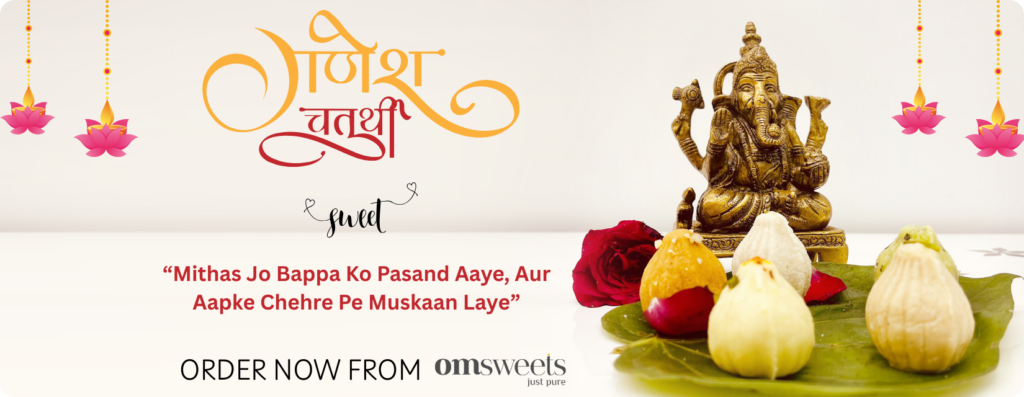Ganesh Chaturthi never arrives quietly in my home. It drums its way in with marigold garlands strung across doorways, turmeric-stained fingers, and coconut shavings scattered on the floor like blessings. For a few magical days, everything ordinary feels utterly enchanted.
While the chants rise and the idols gleam, there’s another ritual I hold close—the one that unfolds quietly in the kitchen. It’s the making of bhog for Ganpati. Not just any meal, but food prepared with such intention, such quiet care, that it lingers in the steam and scent long after the cooking is done.
For me, this Ganesh Chaturthi bhog is more than food. It’s an offering—a prayer made edible. A way to honour, to thank, and to invite grace into the heart of my home.
This isn’t a blog about recipes alone. It’s about what makes the recipe sacred.
Bhog: An Offering, Not a Meal
Food becomes bhog for me the moment it crosses that quiet line between nourishment and offering. It stops being something I cook “for us” and becomes something I prepare for Him—Lord Ganesha, the remover of obstacles, the gentle, wise deity with an unmistakable love for sweet, pleated dumplings.
But for me, this isn’t just about tradition. The offering of Ganesh Chaturthi prasad has always felt like so much more:
- A moment of pause in the middle of all the joyful chaos
- A chance to return to simplicity, to stillness
- A reminder that devotion often smells like roasting semolina or ghee meeting a hot pan
And at the heart of it all is one quiet truth I hold close: purity matters. In the method, in the materials, and most importantly, in the mind that prepares it.
The Canon of Ganesh Chaturthi Bhog: What the Thali Holds
Over the years—and across states—I’ve noticed how certain dishes keep finding their way into the prasad items on my Ganpati thali. Like old friends, they always show up on festival day. Not just because they’re delicious (though they absolutely are), but because they carry something deeper: memories, meanings, and stories folded into every bite.
These dishes have become part of my own celebration rhythm—familiar, comforting, and quietly sacred.
1. Modak
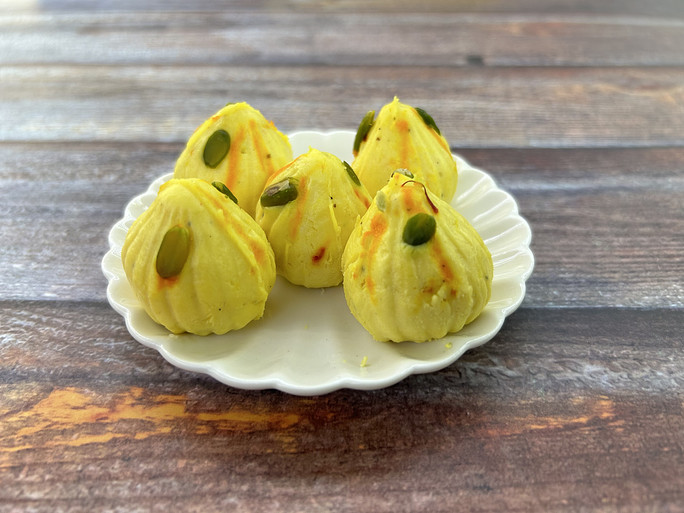
There’s no bhog for Ganesh Chaturthi without modak. Steamed (ukadiche) or fried, these sweet parcels filled with jaggery and coconut are said to be Ganesha’s favourite. You can almost imagine him smiling when the lid is lifted.
2. Puran Poli
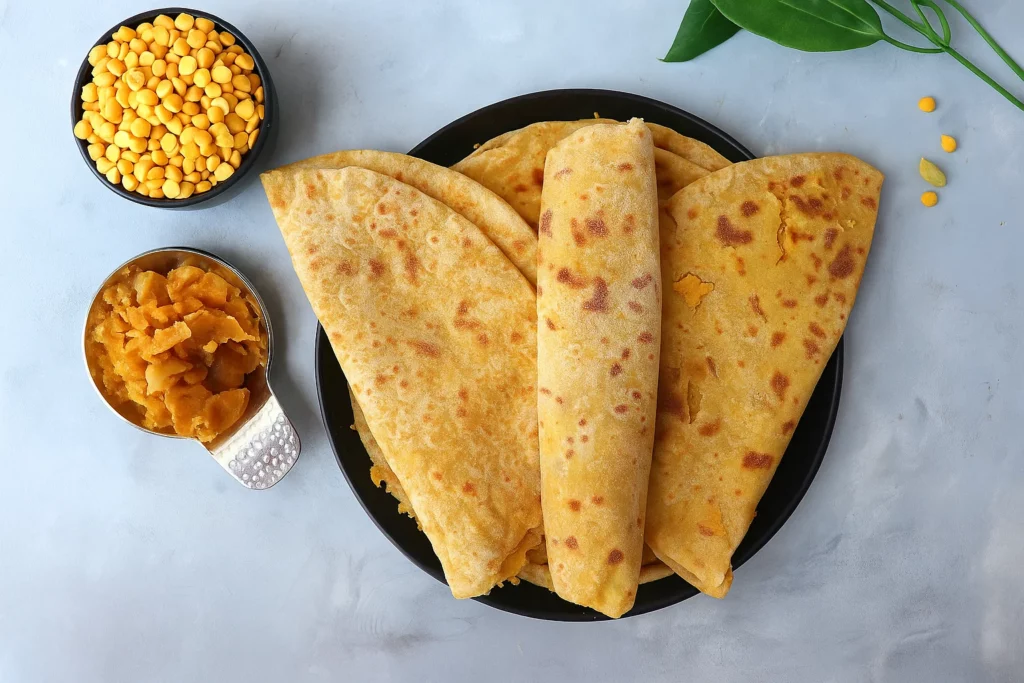
Stuffed with sweetened chana dal, gently flattened, then roasted with ghee until golden and slightly blistered—puran poli is both labour-intensive and oddly meditative to make.
3. Sabudana Khichdi
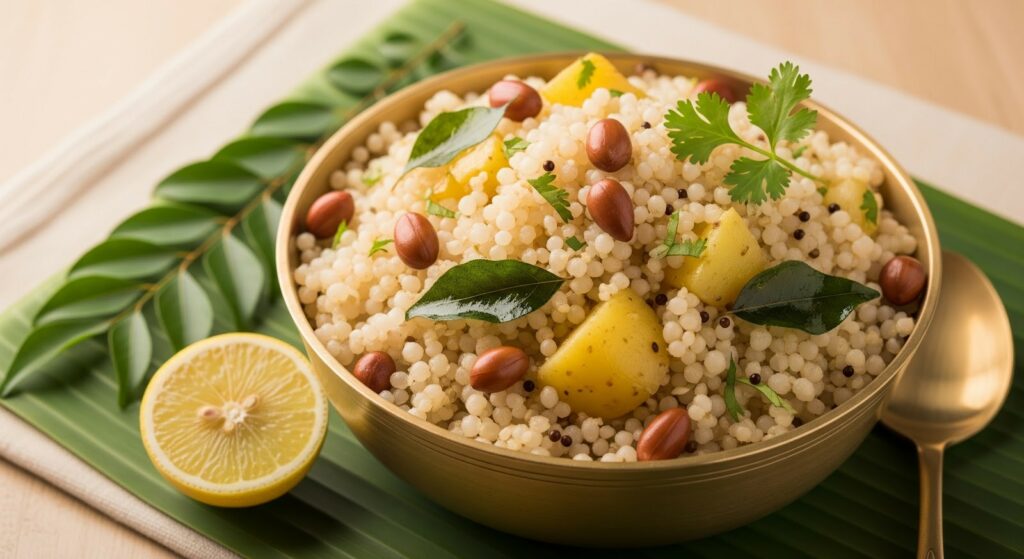
This tapioca pearl dish may be simple, but its flavour profile earthy peanuts, bright green chillies, lemony tang offers surprising complexity. Ideal for fasting days, and even more ideal for sneaky second helpings.
4. Kesar Sheera
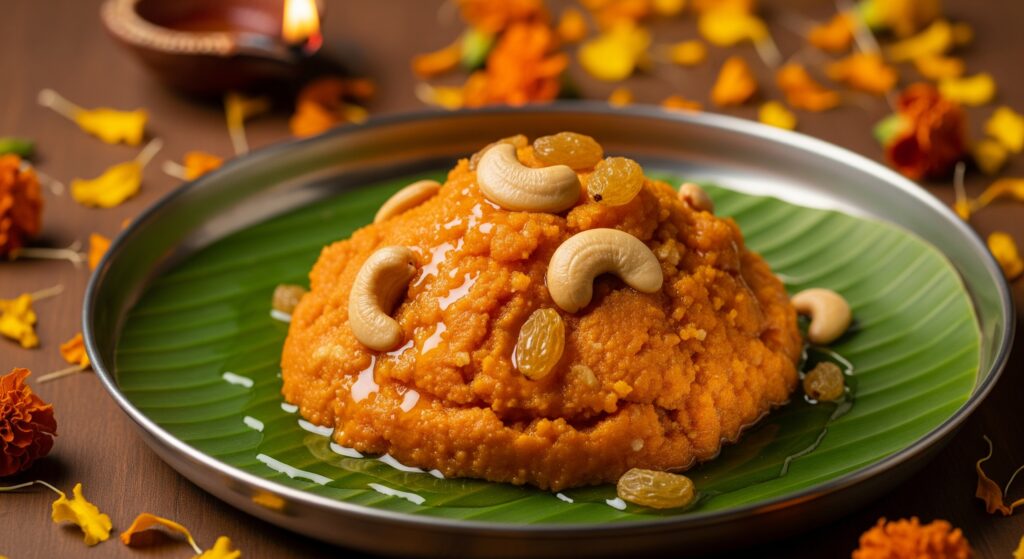
This halwa is sunlight in food form. Saffron, semolina, ghee, and jaggery come together in something that manages to be both decadent and utterly grounding.
5. Coconut Laddoo
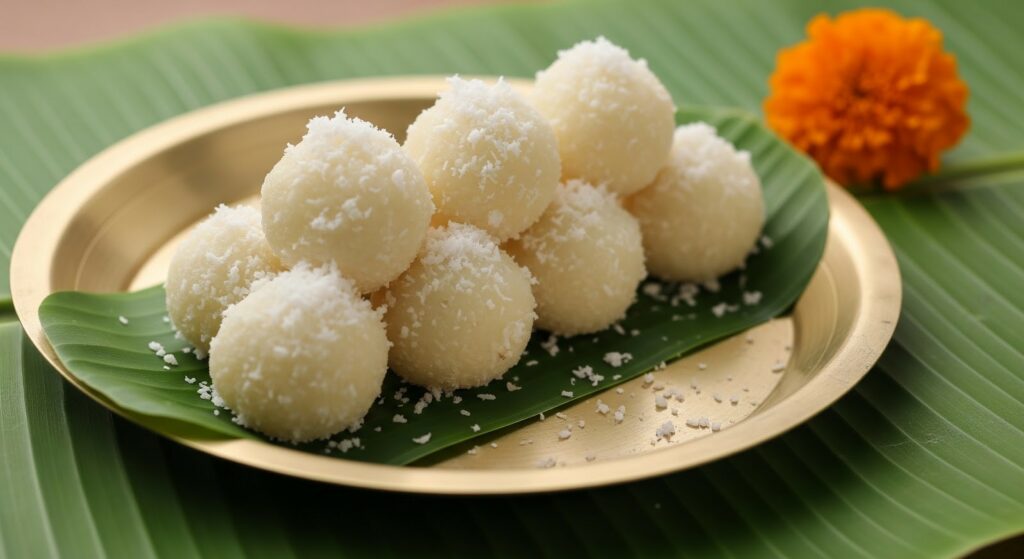
Quick to make, hard to resist. These laddoos feel like edible nostalgia—snowy white and cardamom-scented, they often vanish faster than they’re offered.
6. Fruits
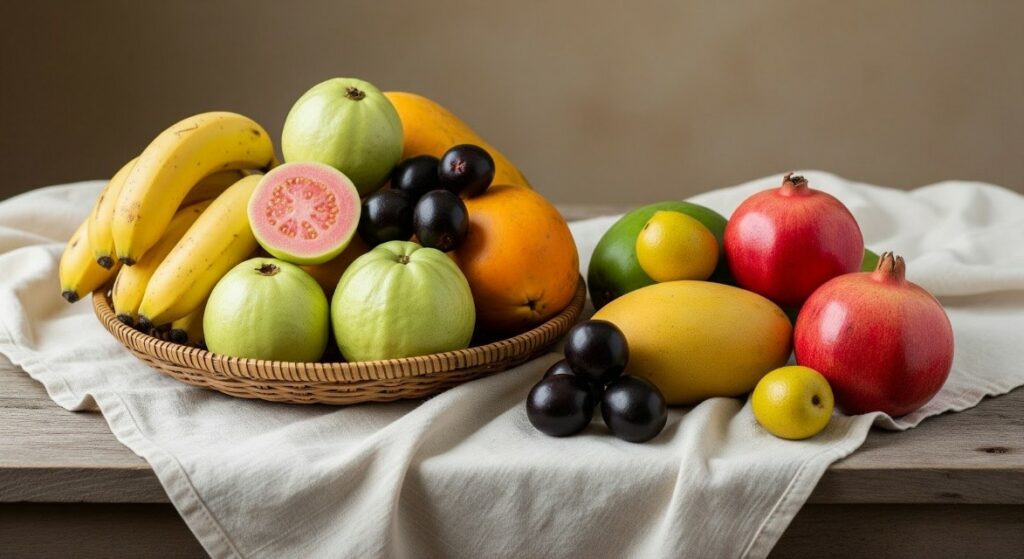
Bananas, guavas, apples—no bells or whistles, just the generosity of nature offered as-is. Sometimes, simplicity does the loudest talking.
7. Panchamrit
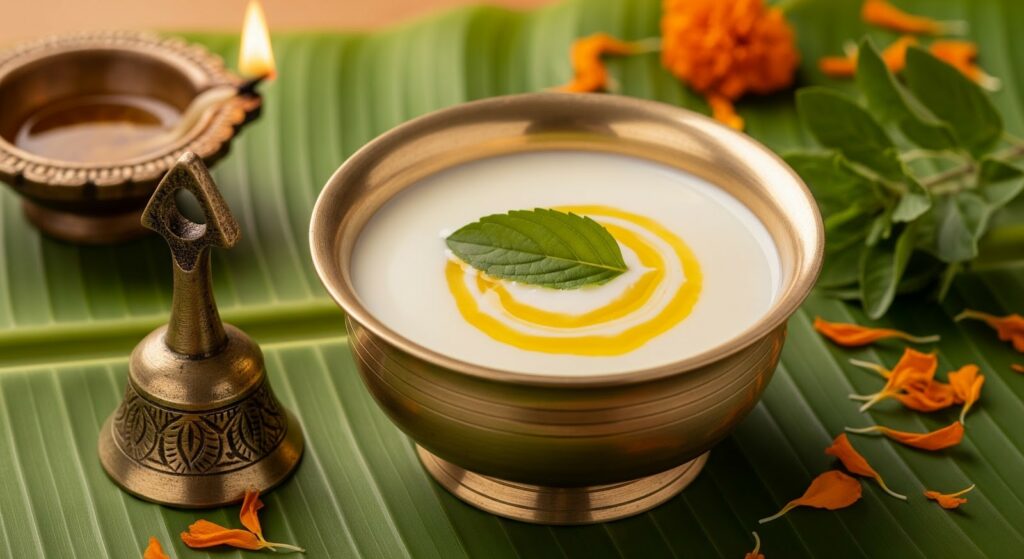
A blend of five sacred ingredients—milk, curd, ghee, honey, and sugar. Used first to anoint, later to nourish. This is ritual in a spoon.
8. Besan or Rava Laddoo
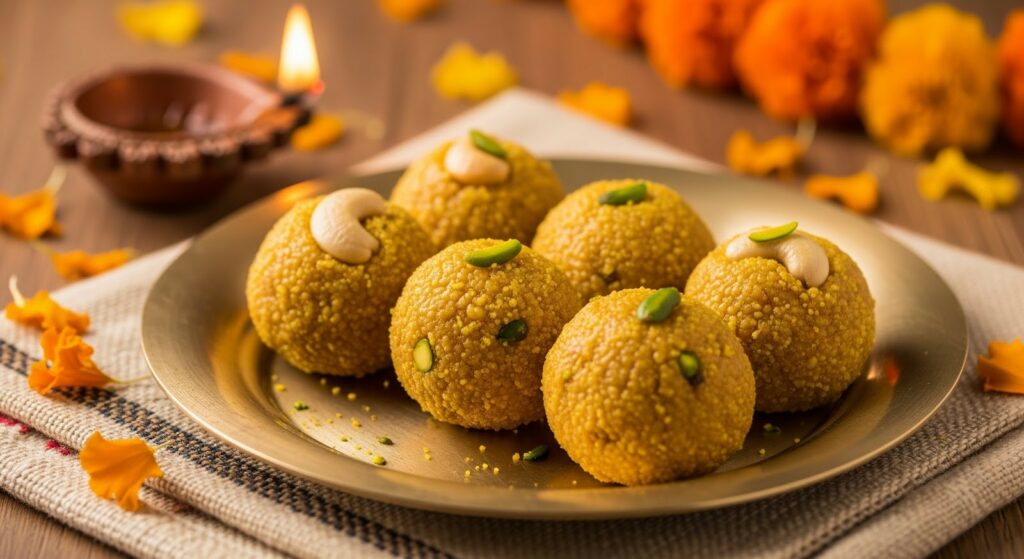
Whether made from roasted gram flour or semolina, these sweets sit heavy with ghee and memory—often rolled by the eldest in the household.
9. Rice and Moong Dal Dishes
In various regions, rice and lentils make a humble yet powerful appearance—sometimes in the form of Pongal, other times as khichdi. Wholesome, grounding, and quietly divine.
Same Festival, Different Plates: Regional Flavours
While the core emotion of devotion remains constant, bhog for Ganpati takes on a distinctly regional flavour depending on where you celebrate:
- Maharashtra: Ukadiche modak, varan bhaat, puran poli
- Tamil Nadu: Payasam, sundal, appam
- Gujarat: Mohanthal, shrikhand, lapsi
- Uttar Pradesh/Bihar: Kheer, malpua, poori-aloo
It’s not about whose version is most “authentic.” It’s about local soil meeting spiritual soil, and something blooming from that mix.
Cooking as Ceremony: Not Just What You Cook, But How
If you’ve ever entered a kitchen mid-festival, you’ll know the energy is different. It’s quieter. Focused. Almost reverent.
A few gentle reminders when preparing your prasad for Ganesh Chaturthi:
• Skip the onion, garlic, and packaged masalas
• Use brass or steel cookware if you can (no non-stick)
• Light a diya while cooking—it changes more than just lighting
• Stir with care, and taste only after offering
• And most of all, don’t rush—this isn’t regular cooking
Your energy, not just your ingredients, flavour the offering.
Building a Bhog Thali That Balances Flavour and Faith
An ideal thali considers both the six rasas (tastes) in Ayurveda and the festival’s spirit of moderation and gratitude.
Sample bhog for Ganpati thali suggestion:
• 2 Steamed Modaks
• 1 Puran Poli
• Sabudana khichdi (small portion)
• Kesar sheera
• Panchamrit
• Seasonal fruits
• Besan laddoo
It’s not a feast for the sake of indulgence—it’s a sattvic, intentional, spiritual plate.
Organic Isn’t a Trend Here—It’s a Return
In today’s processed-everything world, festival cooking is a rare excuse to slow down and strip back. Going organic isn’t about being fashionable—it’s about honouring the source.
Why choose organic for Bhog for Ganesh Chaturthi?
• No chemical interference = cleaner energy
• Richer taste, deeper aroma, better digestion
• Ethically grown, often locally sourced
• Feels like something you’d actually want to offer a god
OMKITCHEN is now offering Ganesh Chaturthi meals and homemade sweets made with cold-pressed ghee, jaggery, and zero preservatives, a gift to yourself and your altar.
Final Thoughts: When Food Transcends Recipe
In the end, bhog for Ganpati has never been about impressing guests, or posting the perfect picture online. It’s not about using exotic ingredients or chasing flawless presentation.
For me, it’s about something much quieter.
It’s about returning, if only once a year to a way of cooking that listens, that respects, that remembers. A kind of cooking where my mind is calm, my hands are gentle, and my heart isn’t just focused on flavour, but on meaning.
When I offer that, I believe it’s received. And that’s enough.
FAQs
Can I prepare bhog the day before?
No, avoid it unless absolutely necessary. Freshness matters. Dry items like laddoos and modaks are okay a day ahead, but mains bhog should be prepared on the same-day.
What’s the difference between naivedyam and prasad?
Naivedyam is what you offer; prasad is what you receive back. It’s food, blessed by faith.
Can I use a microwave or induction stove?
Yes, but maintain cleanliness and mindfulness. The energy you bring matters more than the tool you use.
Any gluten-free or vegan bhog ideas?
Yes! Use rice flour modaks, coconut milk payasam, jaggery-sweetened fruits, and sabudana or millets instead of wheat.
How many dishes do I need?
There’s no fixed number. One well-made dish offered with love is more powerful than ten made in haste.
Read More:
11 Organic Ingredients to Add to Your Janmashtami Bhog This Year
Top 7 Raksha Bandhan Foods That Feel Like a Hug (But Are Healthy Too)
Celebrate Raksha Bandhan Guilt-Free: A Delicious Guide to Healthy Sweets

